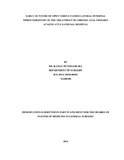| dc.contributor.author | Kamau, Peter K | |
| dc.date.accessioned | 2015-01-13T06:35:54Z | |
| dc.date.available | 2015-01-13T06:35:54Z | |
| dc.date.issued | 2014 | |
| dc.identifier.citation | Degree of Master of medicine in general surgery | en_US |
| dc.identifier.uri | http://hdl.handle.net/11295/79622 | |
| dc.description.abstract | Background:Chronic anal fissures to the general surgeon presents as a common cause of morbidty. Lateral internal sphincterotomy is the gold standard method of intervention. Closed and open techniques at surgery have both been employed. Previous outcome studies have supported closed technique. However, current studies show some evidence in support of open technique. At Kenyatta National Hospital, no study has been done in order to rationalize use of either method of surgery for chronic anal fissures. This study compares the early surgical outcomes of the two methods within six weeks after operation of lateral internal sphinctorotomy. Objective:This is a prospective randomized clinical study comparing the early outcomes of closed versus open lateral internal sphincterotomy in patients with chronic anal fissures in the first six weeks after operation. Study design:A prospective single blinded randomized trial. Setting:The general surgical wards theatres and surgical outpatient clinics at Kenyatta National Hospital Patients and methods:Two treatment groups of patients meeting the inclusion criteria were randomly assigned to either undergo open or closed lateral internal sphincterotomy by the principle investigator just before surgery. Eighty consecutive patients presenting with chronic anal fissure and scheduled for lateral internalsphincterotomy were recruited. They were randomly assigned to two groups, one undergoing open sphincterotomy and the other closed sphincterotomy. Randomization was done using a computer-generated table of random numbers. The operating surgeon was informed of the group designation just before surgery. Data on post-operative outcomes was collected using a formatted questionnaire and analyzed using statistical package for social sciences version 17.0 (SPSS 17.0). Main outcome measures: Post-operative outcomes were amount of bleeding at surgery, haematoma formation, post-operative pain, peri-anal sepsis (abscess), incontinence to flatus and /or stool within six weeks of operation. Results Pain was the commonest presenting symptom (100%). The median age at presentation was 34 years, most anal fissures were located posteriorly (85%) with females reporting more anteriorly placed fissures than men (11% compared to 4% respectively). Most patients (95%) reported no pain 6 hours post-operatively, compared to those reporting no pain at 96 hours (80%). Overall, the post-operative pain score in the closed and open group shows no scientifically significant differences with P values >0.05. At 6 hours, 37 patients who underwent closed procedure had no pain compared to 38 patients in the open group (P=0.556). Only a small number of patients reported bleeding (5 in closed group compared to 6 in open group, p=0.555). There was only one case of reported flatus incontinence at six weeks in the open group. 3 patients in the closed group had peri-anal abscesses compared to only 1 in the open group at two weeks after surgery. Seroma formation was more in the open group compared to closed group (3 cases versus 0). Cases of haematoma formation were reported more in the open group (5 cases) compared to those in the closed group (2 cases) (P= 0.249). In the two groups, the average hospital stay was 2 days. There was no case of reported fissures recurrence within the six weeks follow up period in the two arms.
Conclusion There was no difference in the early surgical outcomes after closed or open lateral internal sphincteromy in the treatment of chronic anal fissure(s) | en_US |
| dc.language.iso | en | en_US |
| dc.publisher | University of Nairobi | en_US |
| dc.title | Early outcome of open versus closed lateral internal sphincterotomy in the treatment of chronic anal fissures at Kenyatta National Hospital | en_US |
| dc.type | Thesis | en_US |
| dc.description.department | a
Department of Psychiatry, University of Nairobi, ; bDepartment of Mental Health, School of Medicine,
Moi University, Eldoret, Kenya | |
| dc.type.material | en_US | en_US |

